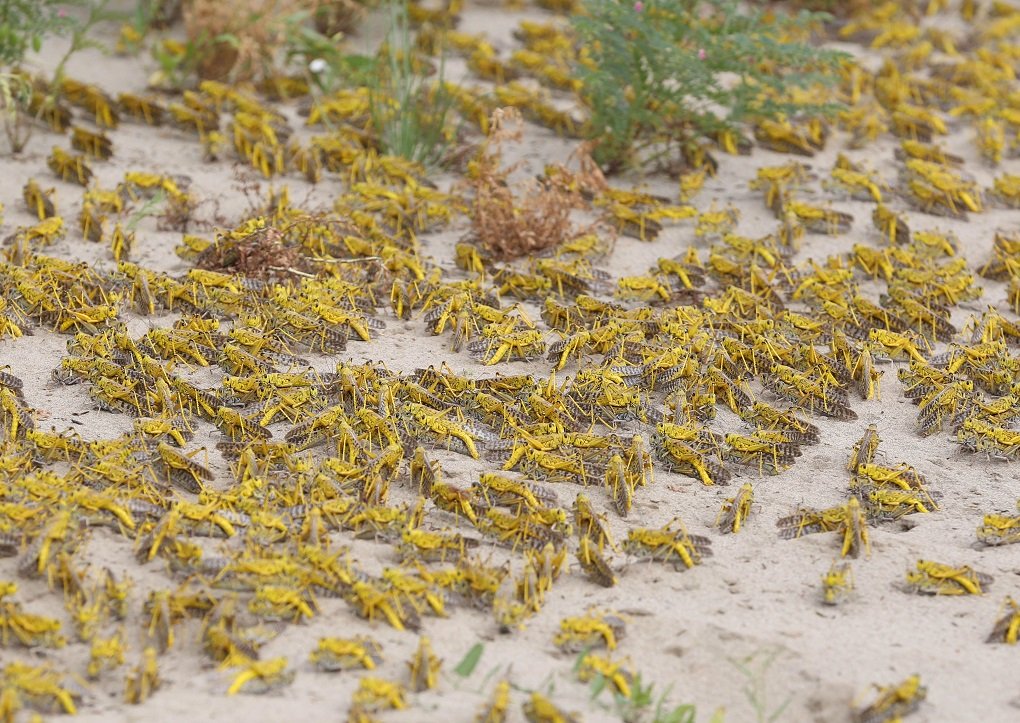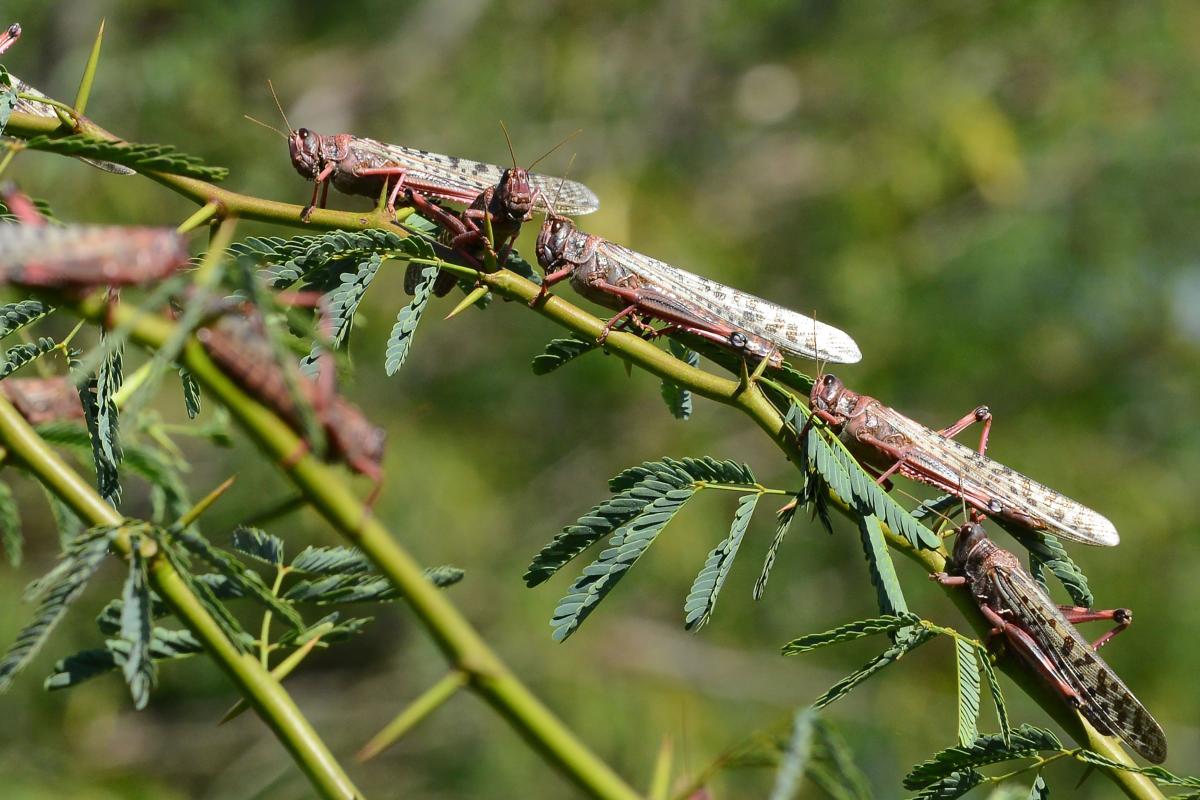Special Desk
Food security is under threat in several states in India as the worst locust outbreak is ravaging West India, threatening to spread further east. Worrisome as several locusts waves are expected from now until early July, due to spring breeding in southern Iran and southwest Pakistan.
UN has warned that the locusts swarm poses severe risk to Indian agriculture sector. And the threat is more is Rajasthan, Gujarat, Maharashtra, Uttar Pradesh and Madhya Pradesh where the locusts are currently active. Rajasthan is currently the most affected state. Measures have been started by the state governments in each state but how far will they help farmers is yet to be seen.
Experts say western Rajasthan and Gujarat are the normal places for desert locusts during the summer (June to November) but were first spotted by the Locust Warning Organisation in April this year. Alarmingly they are usually either solitary or in small groups, meaning the current swarming behaviour is different from what the scientists know.
Devinder Sharma, Agriculture & Trade Policy expert says “The situation is escalating too rapidly and is extremely serious. The swarms have now reached 5 states – Rajasthan, Gujarat, Madhya Pradesh, Uttar Pradesh and Maharashtra. Locusts leave a destruction worse than drought, not only are the crops destroyed but even trees collapse under their weight. This year the locusts are breeding 400 times more than usual due to the favourable climatic conditions brought on by the untimely rains and increased cyclonic activity. The government preparedness has been too slow to keep up with this rapid increase.“
The Locust attack has put several things at stake. This includes attack as sowing season starts for kharif, rice, maize, millet, pulses, soybeans. Damage to the agricultural economy and agricultural workers’ livelihoods. Potential risk to food supply if the outbreak is not contained.
Ajayvir Jakhar, Chairman, Bharat Krishak Samaj (Indian Farmers’ Forum) says “India’s central government has to go beyond giving alerts and advisories on managing the locust outbreak, and immediately arrange for aerial sprays of pesticides to control the rapidly escalating situation. The states do not have the wherewithal to manage the scale of the outbreak this year.”

Link with Climate Change
Climate change made the weather conditions conducive to the current outbreak (still ongoing in East Africa) more likely, with extreme and unusual weather, including a powerful cyclone season last year, creating the wet conditions that fuelled the outbreak. The same is true in India.
Locusts thrive in wet conditions, and outbreaks often follow floods and cyclones. Heavy rain leads to growth of vegetation in arid areas, providing locusts with the conditions needed to develop and reproduce, according to the World Meteorological Organization (WMO).
The 2019 North Indian Ocean Cyclone season was the most active ever recorded. India has had an unusual monsoon season, lasting 1 month longer than normal, causing extensive flooding and the highest level of Monsoonal rain in 25 years. It has also had an unusual number of low pressure systems (meaning more rain) linked to an ocean circulation pattern known as the Indian Ocean Dipole (IOD), which measures the difference in water temperature between opposite sides of the Indian Ocean. IOD is a primary driver of climate conditions stretching from Africa to Australia.
The positive phase of the IOD in 2019 was the strongest for six decades. These conditions led to severe rainfall and flooding in East Africa, as well as contributing to the unusually dry conditions in Australia that drove the current bushfires and the monsoon extension in India.
The positive phases of the IOD are becoming more common, and scientists believe climate change is responsible. Academic studies have found that strongly positive phases of the IOD have happened more often in recent decades, and that climate change is behind the increase.
As greenhouse gases continue to heat the ocean and the atmosphere, extreme events caused by the IOD are predicted to become increasingly common. Unusually positive IOD events could happen nearly three times more often this century if emissions continue to rise, according to a 2014 study. A separate study also found they would be twice as likely to happen even with only 1.5°C of warming – little more than has already been seen.
Increased extremely positive IOD years would likely bring flooding and cyclones like those seen in 2019 to already vulnerable and food insecure regions. Wet conditions could also lead to worse locust outbreaks – in a worst-case scenario they could damage the livelihoods of one tenth of the world’s population, according to the FAO (p2).
Spread from East Africa
The outbreak originated in East Africa and is the worst upsurge Eritrea, Ethiopia and Somalia have experienced in the last 25 years, Uganda in 60 years and Kenya in 70 years. The outbreak came on the heels of a year marked by extreme droughts and floods in these regions. As a result, the UN appealed for $138m to tackle the escalating crisis. The World Bank recently approved $500 million in grants and low interest loans. The African Development Bank has also approved a $1.5 million emergency grant.
The current outbreak in East Africa, is described as ‘extremely alarming’ by UN Food and Agriculture Organization (FAO), and is threatening food security and livelihoods. The second generation is already hatching and the third generation will hatch in late June/July, coinciding with the harvest season, according to FAO. This can severely threaten the food security and livelihoods of the region’s rural population and fuel famines depending on the magnitude of production losses.

The outbreak is an ‘unprecedented threat’ to food security, occurring in a region that is already vulnerable to the impacts of climate change. Even before this outbreak, at least 33 million people in east and south Africa were at emergency levels of food insecurity as a result of floods, landslides, droughts and cyclones, according to analysis by Save the Children.
The locust outbreak is likely to continue to develop to South Sudan, Uganda, Oman, Pakistan, India, Saudi Arabia and Southern Iran, among other countries, threatening livelihoods as it expands. The swarms are expected to worsen over the coming months as the locusts feed on the new season’s crops.
The outbreak, paired with COVID-19, will likely aggravate acute food insecurity in an already complex and fragile region. In Somalia, in the period from April–June, the number of acutely food-insecure people was projected to increase by 13% to 1.3 million people due to drought and conflict, while 1.5 million people will likely face a severe food crisis in Uganda for the same reasons. Somalia already announced a national state of emergency due to the outbreak in February 2020, while Pakistan declared a national emergency for the second time this year in April.
What are locusts and how are they controlled?
Locusts are part of the same family as grasshoppers but under crowded conditions their behaviour and appearance evolve – this is called Phase Change. These crowded conditions are caused by plentiful rainfall and vegetation growth and allow formation of bands of wingless hoppers. If uncontrolled, the population will increase and the locusts will move to a gregarious state.
When Phase Change occurs (described as a shift from solitary to gregarious state), locusts no longer act as individuals, but as a swarm. Since gregarious locusts are much more adaptable to their environment than their solitary type, they tend to cover much bigger areas and are therefore a cause for concern. If two or more regions have swarms, a plague develops, as has happened in East Africa and India.
The desert locust (currently in India) is present in 30 countries (16 million sq km) in its solitary form but more than 60 (29 million sq km) during plagues.
Desert locust biology is dependent on weather, specifically rainfall, temperature and wind. Rainfall – Eggs, Hopper and Adult stages of development are all assisted by recent rainfall. 2019/20 has been extremely wet for both East Africa and India.
The desert locust is a passive flying species, i.e it typically follows the wind. Predictions by NOAA on wind patterns are being used by the FAO to try to predict spread though these are not yet linked to the locust lifecycle. Concerningly, the prevailing wind in Rajasthan from April to October is from the west. Swarms are unlikely to take off, however, when wind conditions are faster than 6-7 m/s.
Keith Cressman, Senior Locust Forecasting Officer, FAO says “As Desert Locust are fully integrated with nature, weather and environmental conditions have dramatic impacts on locust numbers and migration.” Historically, heavy rains associated with cyclones that form in the Indian Ocean and make landfall in the Arabian Peninsula and the Horn of Africa have led to Desert Locust plagues.
In the past few years, there has been a significant increase in the frequency of such cyclones at the beginning and end of the summer period. For example, there were 8 cyclones in 2019 when in most years there are only one or two. Three cyclones in 2018 and two in 2019 have contributed to the current Desert Locust upsurge in the Horn of Africa where large and numerous swarms are present in Ethiopia, Somalia and Kenya.
also read: Nehru’s romantic affair with “Gori” Edwina and hypocrisy of Indian Politics
also read: Killing zoo animals to feed other
Professor Axel Hochkrich, Trier University said, “Climate change may well play a role here, mainly because, according to forecasts by international climate researchers, precipitation will increase in the southern Arabian Peninsula and northern East Africa. This means that there will be more frequent very humid phases, such as we have had since 2018, and it is therefore possible that such swarms will simply occur more frequently.”
Dr Roxy Mathew Koll, Senior Scientist, Indian Institute of Tropical Meteorology and Lead Author, IPCC Oceans and Cryosphere says the outbreak started after warm waters in the western Indian Ocean in late 2019 fueled heavy amounts of rains over east Africa and the Arabian Peninsula. These locusts which migrated to India early this year might have found greener pastures as the pre-monsoon rains during March–May were in excess over north India this year.
 Jubilee Post News & Views
Jubilee Post News & Views





